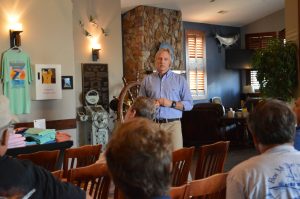
WEST OCEAN CITY – Local fishermen met with federal officials this week to share their concerns regarding the use of offshore sand reserves for Ocean City’s beach replenishment projects.
On Tuesday, representatives with the U.S. Army Corps of Engineers (ACE) met with fishermen in a public meeting at the Ocean City Marlin Club to communicate with stakeholders ongoing efforts to explore federal waters for shoals that could be used to supply dredged material for Ocean City’s beach replenishment project.
“You need to get sand from somewhere,” Project Manager Justin Callahan said, “and the only thing we are trying to do in this meeting is ascertain where is the best of these candidate shoals to take from that will be least impactful to the fishing community.”
The federal agency – in partnership with the town, Worcester County and the state of Maryland through a 50-year agreement – began beach replenishment along the coast of Ocean City in 1994, taking sand from nearby shoals in state waters to fortify the beach. After the latest round of beach replenishment concluded late last year, however, it was discovered that traditional borrow areas became exhausted and new sites in federal waters would have to be explored.
In 2008, ACE prepared an environmental assessment of potential sand borrow areas located in federal waters that could be used to supply dredged material for Ocean City’s beach replenishment program in the future. That assessment, according to ACE’s Christopher Spaur, identified four shoals in federal waters that met environmental, engineering and economic needs. The sites included Weaver Shoal, Isle of Wight Shoal, Shoal A and Bass Grounds, which was determined unsuitable because of it’s high value as a fishing grounds.
“We are really thinking at this point shoals Weaver and Isle of Wight,” he said.
Beach replenishment in Ocean City is conducted in a four-year cycle, and, barring any future storms, the next round in the project is not scheduled until 2022. However, since a decade has passed since the last environmental assessment, officials with ACE are working to produce a supplemental environmental assessment of shoals in federal waters and seek input from stakeholders with concerns.
“Because we haven’t dredged where we said we would for 10 years, and because things may have changed, we have to go through this process again,” Spaur told the fishermen.
Finn McCabe of the Atlantic Coast Sportfishing Association questioned why sand would be taken from shoals instead of other areas along the seafloor.
“The shoals are the oasis for the fish that live there,” he said. “Why aren’t we doing the seafloor flats instead of the shoals?”
Spaur explained course sand, as well as mud, found on the seafloor flats would not be suitable for the beaches of Ocean City. He noted that sand too course would make the beach too steep.
“It gets to be an engineering problem,” he said.
One fisherman in attendance questioned how the shoals, and the fish, would be impacted.
“Do you have any reasonable expectation for what’s going to happen to the shoals?” he said.
Spaur explained that taking sand from certain areas along the shoals would limit impacts to marine habitats.
“Most of the fish out there can get away from our dredge,” he said. “Overtime, with guidelines in place, we think we could keep the impact to the shoal crest to a level that will maintain their functions for providing habitat.”
Fish in OC magazine publisher Scott Lenox said he was pleased at the agency’s proposed plan.
“I was under the assumption that you guys were going to do what you did with the state water shoals, knock them down to dust and leave them be so they never come back,” he said, “but if this is the new approach it seems pretty good.”
Attendee Steve Doctor said he was hesitant to see the Isle of Wight shoal used as a sand borrow area, but said he supported the use of Weaver and Shoal A.
“Those are the two I would prefer,” he said.
Following feedback on potential shoaling locations, discussion digressed to navigational issues at the Ocean City Inlet.
Callahan noted that nearly 200,000 cubic yards of sand leave the beach each year and moves south toward the Inlet.
“The north side of the jetty collects sand … and then the rest of that sand circulates around and some of it is intercepted by the Inlet system,” he said.
Attendee John Evans, who said he has fished out of Ocean City since the 1950s, asked if there were any ongoing plans to address increasingly shallow waters at the Inlet. He argued shoaling in the area has gotten worse since beach replenishment projects began.
“The Inlet has changed dramatically, probably more dramatically since they started doing the beach replenishment, and I think everyone here agrees that most of the sand we lose each year comes into the Inlet,” he said. “How do we solve this problem because all we are doing is putting a Band-Aid on it.”
ACE’s Tony Clark said officials are pursuing a study to find a long-term solution to the chronic Inlet shoaling problem, which could possibly include a structure within the area to manage ongoing issues.
“I don’t think we are ever going to stop the problem, but we are looking for ways to manage the shoaling,” he said.
Callahan added that maintenance dredging will return to the Inlet later this month ahead of the White Marlin Open.
A draft document of the supplementary environmental assessment will be released to the public for review and comments this winter. For more information, contact Christopher Spaur at [email protected] or call 410-962-6134. Information about the assessment will be posted at http://www.nab.usace.army.mil/.

